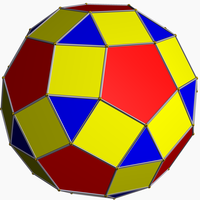Small rhombicosidodecahedron
| Small rhombicosidodecahedron | |
|---|---|
 | |
| Rank | 3 |
| Type | Uniform |
| Notation | |
| Bowers style acronym | Srid |
| Coxeter diagram | x5o3x ( |
| Conway notation | eD |
| Stewart notation | E5 |
| Elements | |
| Faces | 20 triangles, 30 squares, 12 pentagons |
| Edges | 60+60 |
| Vertices | 60 |
| Vertex figure | Isosceles trapezoid, edge lengths 1, √2, (1+√5)/2, √2  |
| Measures (edge length 1) | |
| Circumradius | |
| Volume | |
| Dihedral angles | 4–3: |
| 5–4: | |
| Central density | 1 |
| Number of external pieces | 62 |
| Level of complexity | 4 |
| Related polytopes | |
| Army | Srid |
| Regiment | Srid |
| Dual | Deltoidal hexecontahedron |
| Conjugate | Quasirhombicosidodecahedron |
| Abstract & topological properties | |
| Flag count | 480 |
| Euler characteristic | 2 |
| Surface | Sphere |
| Orientable | Yes |
| Genus | 0 |
| Properties | |
| Symmetry | H3, order 120 |
| Convex | Yes |
| Nature | Tame |
The small rhombicosidodecahedron, or srid, also commonly known as simply the rhombicosidodecahedron, is one of the 13 Archimedean solids. It consists of 20 triangles, 30 squares, and 12 pentagons, with 1 triangle, 2 squares, and 1 pentagon meeting at each vertex. It can be obtained by cantellation of the dodecahedron or icosahedron, or equivalently by expanding either polyhedron's faces outward.
Vertex coordinates[edit | edit source]
A small rhombicosidodecahedron of edge length 1 has vertex coordinates given by all permutations of
- ,
along with all even permutations of
- ,
- .
Representations[edit | edit source]
A small rhombicosidodecahedron has the following Coxeter diagrams:
- x5o3x (




 ) (full symmetry)
) (full symmetry) - oxxFofxx5xxfoFxxo&#xt (H2 axial, pentagon-first)
- xx(oF)fVxF(Vx)fo3of(Vx)FxVf(oF)xx&#xt (A2 symmetry, triangle-first)
- xoF(Af)V(xB)F(xB)V(Af)Fox xFf(oV)F(Bx)A(Bx)F(oV)fFx&#xt (K2 axial, square-first)
Semi-uniform variant[edit | edit source]
The small rhombicosidodecahedron has a semi-uniform variant of the form x5o3y that maintains its full symmetry. This variant has 12 pentagons of side length x, 20 triangles of side length y, and 30 rectangles as faces.
With edges of length a (of pentagons) and b (of triangles), its circumradius is given by and its volume is given by .
It has coordinates given by all even permutations of:
- ,
- ,
- .
where .
Related polyhedra[edit | edit source]
The small rhombicosidodecahedron is the colonel of a three-member regiment that also includes the small dodecicosidodecahedron and the small rhombidodecahedron.
It is possible to cut off a pentagonal cupola cap from the rhombicosidodecahedron to diminish it, or to gyrate any such cap by 36° (so squares connect to other squares, and triangles connect to pentagons). The various combinations of diminishings and gyrations lead to a total of 12 Johnson solids:
- Gyrate rhombicosidodecahedron - One cap rotated
- Parabigyrate rhombicosidodecahedron - Two opposite caps rotated
- Metabigyrate rhombicosidodecahedron - Two non-opposite, non-adjacent caps rotated
- Trigyrate rhombicosidodecahedron - Three non-adjacent caps rotated
- Diminished rhombicosidodecahedron - One cap removed
- Paragyrate diminished rhombicosidodecahedron - One cap removed, the opposite cap rotated
- Metagyrate diminished rhombicosidodecahedron - One cap removed, another non-opposite, non-adjacent cap rotated
- Bigyrate diminished rhombicosidodecahedron - One cap removed, two more non-adjacent ones rotated
- Parabidiminished rhombicosidodecahedron - Two opposite caps removed
- Metabidiminished rhombicosidodecahedron - Two non-adjacent, non-opposite caps removed
- Gyrate bidiminished rhombicosidodecahedron - Two non-opposite caps removed, a third non-adjacent one rotated
- Tridiminished rhombicosidodecahedron - Three non-adjacent caps removed
External links[edit | edit source]
- Bowers, Jonathan. "Polyhedron Category 4: Trapeziverts" (#39).
- Klitzing, Richard. "srid".
- Quickfur. "The Rhombicosidodecahedron".
- Wikipedia contributors. "Rhombicosidodecahedron".
- McCooey, David. "Rhombicosidodecahedron"
- Hi.gher.Space Wiki Contributors. "Rhodoperihedron".




















